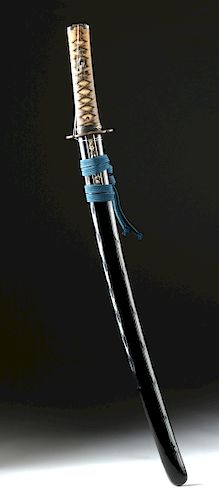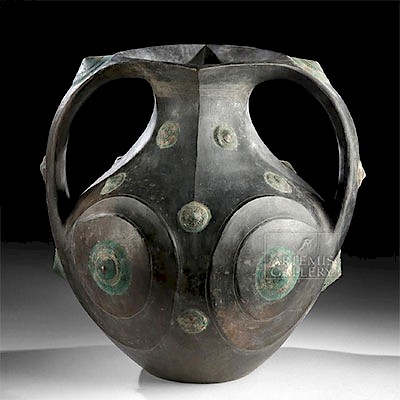Signed Japanese Edo Steel Wakizashi w/ Kotagana
Lot 122a
About Seller
Artemis Fine Arts
686 S Taylor Ave, Ste 106
Louisville, CO 80027
United States
Selling antiquities, ancient and ethnographic art online since 1993, Artemis Gallery specializes in Classical Antiquities (Egyptian, Greek, Roman, Near Eastern), Asian, Pre-Columbian, African / Tribal / Oceanographic art. Our extensive inventory includes pottery, stone, metal, wood, glass and textil...Read more
Categories
Estimate:
$3,500 - $5,000
Absentee vs Live bid
Two ways to bid:
- Leave a max absentee bid and the platform will bid on your behalf up to your maximum bid during the live auction.
- Bid live during the auction and your bids will be submitted real-time to the auctioneer.
Bid Increments
| Price | Bid Increment |
|---|---|
| $0 | $25 |
| $300 | $50 |
| $1,000 | $100 |
| $2,000 | $250 |
| $5,000 | $500 |
| $10,000 | $1,000 |
| $20,000 | $2,500 |
| $50,000 | $5,000 |
| $100,000 | $10,000 |
| $200,000 | $20,000 |
About Auction
By Artemis Fine Arts
Jul 11, 2019
Set Reminder
2019-07-11 10:00:00
2019-07-11 10:00:00
America/New_York
Bidsquare
Bidsquare : Ancient / Ethnographic / Americana
https://www.bidsquare.com/auctions/artemis-gallery/ancient-ethnographic-americana-4246
Discover ancient art from Egypt, Greece, Italy, and the Near East, as well as Asian, Pre-Columbian, Tribal, Fossils and Fine Art. Also featuring a wonderful collection from a prominent New York estate whose owners reside in the Van Wyck family's historic Lloyd Harbor waterfront home. Artemis Fine Arts info@artemisfinearts.com
Discover ancient art from Egypt, Greece, Italy, and the Near East, as well as Asian, Pre-Columbian, Tribal, Fossils and Fine Art. Also featuring a wonderful collection from a prominent New York estate whose owners reside in the Van Wyck family's historic Lloyd Harbor waterfront home. Artemis Fine Arts info@artemisfinearts.com
- Lot Description
East Asia, Japan, Edo Period, ca. 1603 to 1868 CE. A beautiful wakizashi with a single-edged blade, a scabbard (saya) made of lacquered (urushi) wood with a silver cap (kojiri) and a gilded (23%) copper by-knife (kotagana), and a handle (tsuka) wrapped with stingray skin (same) and two copper dragon ornaments (menuki) inside cotton straps (tsuka-ito) topped with a gilded (56%) copper cap (kashira). The lobed iron hand guard (mokko tsuba) bears a singular figure among a mountainous scene and is signed "Yamashiro koku Fushimi ju Kaneie" around the blade opening. The shinogi-zukuri carbon-steel blade has a diamond-shaped (iori-mune) profile, a lightly curved (chu-kissaki) tip, and a gentle wave (notare-hamon) just above the blade edge formed by the tight-grained hammer-folding process (itame-hada). The tang is hammered with the signature, "Hizen koku junin Yoshitsugu saku." Size (w/ sheath): 2.75" W x 30" H (56.5 cm x 7 cm x 76.2 cm); length of blade: 22.25" L (56.5 cm); quality of gilding: 23% (kotagana) and 56% (kashira).
This traditional Japanese sword was both a weapon and a symbol of authority and social status. The wakizashi paired with the longer katana sword marked the wearer as a samurai. The shorter sword was seen as an auxiliary weapon, also used for fighting in close quarters. Wakizashi could also be worn by non-samurai if worn alone, and members of the merchant class (chonin) wore them because of the frequency of encountering bandits when traveling between Japan's cities.
Over the centuries that katana and wakizashi were made, the process of their manufacture became heavily regulated. For example, in 1683, the Tokugawa Shogunate made laws concerning the maximum size of katana and wakizashi. Meanwhile, once a samurai took ownership of his new weapon, he had to wear it in a highly-regulated manner. Wakizashi and katana in this period were both deadly weapons and signs of prestige. The craftsmanship of this piece is evident and reflects hundreds of hours of work.
A stylistically-similar example consisting of just the blade portion hammered for $6,875 at Christie's, New York "Legacy & Heritage: The De Guigne Collection" auction (sale 12189, March 24, 2016, lot 163): https://www.christies.com/lotfinder/lot/a-japanese-wakizashi-sword-mid-17th-century-5973287-details.aspx?from=searchresults&intObjectID=5973287&sid=9edd4ac5-464a-44a9-9d23-279357e6ff26
Provenance: private Jones collection, Boulder, Colorado, USA
All items legal to buy/sell under U.S. Statute covering cultural patrimony Code 2600, CHAPTER 14, and are guaranteed to be as described or your money back.
A Certificate of Authenticity will accompany all winning bids.
We ship worldwide and handle all shipping in-house for your convenience.
#146848Blade is from the Edo Period; handle, tsuba, scabbard, by-knife, and cotton wraps are all likely from a later period. Handle peg repaired from two pieces. Blade has minor nicks and abrasions to shoulder, edge, and tang, with softening to some inscribed characters of signature on tang, otherwise intact and excellent. Handle has darkening to color of wraps, sheath has minor abrasions and darkening to silver cap, and tsuba has softening to some finer details and signature. Fine patina throughout.Condition
- Shipping Info
-
All shipping is handled in-house for your convenience. Your invoice from Artemis Gallery will include shipping calculation instructions. If in doubt, please inquire BEFORE bidding for estimated shipping costs for individual items.
-
- Buyer's Premium



 EUR
EUR CAD
CAD AUD
AUD GBP
GBP MXN
MXN HKD
HKD CNY
CNY MYR
MYR SEK
SEK SGD
SGD CHF
CHF THB
THB


















